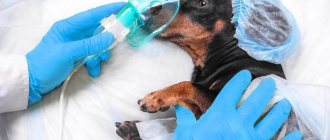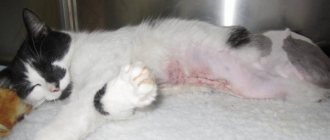Sterilization is a very important stage in the life of every cat and, of course, its owners. At this time, your pet needs to be given as much attention and care as possible. Most often, the operation goes away without a trace and within a couple of days the pet returns to a full life. However, there are exceptions and the cat behaves strangely, to put it mildly... Increased body temperature, rapid breathing, inflammation of the suture - these are not all the symptoms of the unfavorable condition of the cat after the sterilization procedure. There is another one that very often scares cat owners. What does such a symptom as trembling indicate and whether it is necessary to sound the alarm, we will discuss further.
Why might a cat tremble after sterilization?
There can be many reasons for trembling and these will be discussed further.
After all, the most important thing in this situation is to be able to understand the reasons for the appearance of this symptom.
It is also important to understand at what point you should seek help.
The process of recovery from anesthesia
When recovering from anesthesia, the cat will have poor coordination and may tremble. This is a normal reaction to medications. Usually such trembling does not last long and does not carry anything bad.
Advice!
Observe your pet, do not leave her alone and monitor all changes occurring in her condition. If everything is in order, then after a while the trembling will pass.
Frozen
Cats are very warm-blooded animals and the optimal room temperature for them is about 20 degrees. All cats tremble even after a regular bath, let alone any temperature changes.
As you know, body temperature decreases during sleep. The same thing happens while under anesthesia, that is, the cat may simply freeze, which will provoke trembling.
Advice!
To prevent this from happening, you need to place your pet next to a warm radiator or place a heating pad near it. You can try to cover your pet with a warm blanket, but most likely this will not be successful, because animals behave very restlessly when they come out of anesthesia.
The blanket is in the way
Some animals do not perceive any foreign objects on their bodies. One of these things (alien to the animal) is a blanket, which is put on after the sterilization procedure.
By trembling, the animal may try to remove the blanket and thereby relieve itself of discomfort.
Attention!
Some cats shake when they are stressed, and the cause of discomfort may be the same blanket.
In this case, you can try to wait until the cat calms down or consult a veterinarian about removing the blanket for a short period of time. If the doctor approves this step, then it is important to ensure that the cat does not stain the stitch or lick it under any circumstances. At this time, you need to keep an eye on your pet.
Natural bowel movements, appetite and thirst
It is necessary to ensure that the cat goes to the toilet on the first day after surgery. Frequent trips to the toilet should also alert you, as should the complete absence of bladder and bowel movements. In case of reflex postoperative constipation (no bowel movement for up to 3 days), you will need to give a laxative, after consulting with your veterinarian.
Normal active appetite and thirst should return on the second or third day. By this time, the cat is already showing a normal interest in food and drink, so it is already asking for food and drinking on its own according to its needs. Important: it is not recommended for a cat to eat a lot after sterilization. What to do if he asks to feed often? It is enough to reduce food portions. Neutered cats are prone to obesity due to increased appetite due to hormonal changes, so their diet and feeding regimen will have to be monitored more carefully than before surgery.
Carbon monoxide poisoning
This type of poisoning can be provoked by prolonged stay in places where cars accumulate, near highways, highways, in parking lots, in garages when the car engine is warming up, in cramped rooms with low oxygen concentrations, in case of gross violations of the operation of stoves in baths and saunas and, of course, in case of fires and major fires.
Signs of CO Poisoning
Blue complexion, loss of consciousness. In severe poisonings, deaths are common due to respiratory arrest and cardiac arrest.
Symptoms
- dizziness and headache
- active lacrimation or pain in the eyes
- nausea and vomiting
- dry, persistent cough and chest pain
- shortness of breath
Reactions to a high concentration of carbon monoxide in the lungs can be different, including visual and auditory hallucinations, rapid heartbeat, redness of the skin, involuntary urination and defecation, severe convulsions, and the victim’s reaction to light decreases. The danger lies in the appearance of an increasing drowsiness and the onset of complete motor paralysis, followed by the development of coma.
In the future, with complications of coma, cerebrovascular accident, visual impairment, and cerebral edema may occur. Possible skin lesions in the form of blisters and subsequent death of skin cells due to necrosis, the development of pneumonia.
First aid for gas poisoning
The very first thing to do is provide the victim with fresh air. Take him outside and lay him on his back. Allow him to breathe freely; if his chest is constrained by clothing, you need to remove it. It is imperative to ensure that the victim is breathing and that they are able to breathe on their own. If breathing is not heard or is barely noticeable, artificial respiration is necessary.
To eliminate the negative effects of inhaling carbon monoxide vapor, you can give the victim a cotton swab to sniff and thoroughly rub his body.
To avoid negative consequences and complications of the nervous and respiratory systems, you need to take the person to the nearest medical center. It is worth noting that the sooner you take the victim to the hospital, the better. This is necessary to ensure that oxygen therapy can be used as quickly as possible, since clean air is crucial for it.
With mild carbon monoxide poisoning, nausea may occur, but you can easily cope with it with a 0.5% solution of novocaine inside the body. Strong tea or coffee will help.
Alcohol poisoning
Some substances containing ethyl alcohol and ethanol, when ingested, have a damaging effect on the human central nervous system. As a result of reactions in the body, ethanol is converted into a combination of acetaldehyde and acetic acid. It is these compounds that affect the internal organs and tissues of the body causing poisoning.
Signs of alcohol poisoning
- impaired coordination of movement (uncertain gait, staggering);
- emotional instability;
- redness of the skin (red face);
- gagging and nausea;
- in severe poisoning, loss of motor activity, impaired consciousness and depression of respiratory function
Ignorance of limits, abuse of alcoholic beverages, and simply poisoning sometimes leads to serious consequences. They are characterized by:
- comatose state with complete loss of consciousness
- decreased pain reflexes
- impairment of human visual functions
Symptoms of this condition are:
- constricted pupils or pupils of different sizes, most often this depends on impaired respiratory function
- slow muscle reactions and reflexes
Experts divide the state of alcoholic coma into two stages. The first stage is characterized by weak reactions to pressure on pain points, injections, and strong odors (ammonia vapor). It is expressed in weak retaliatory attempts to defend oneself with one’s hands and brush them off.
The second stage of alcohol poisoning is characterized by an almost complete lack of reaction to pain, while the pupils practically do not react to light at all.
The development of deep coma during poisoning is characterized by a decrease in all physical activity, reflexes and movement, and a decrease in body temperature. The most dangerous thing is the lack of medical care for respiratory dysfunction in this condition. This is the main cause of death from ethanol poisoning.
The most common phenomena in deep alcoholic coma are:
- profuse salivation
- tongue retraction
- hoarse weak breathing
- nausea (especially dangerous if vomit enters the respiratory tract)
- bluish complexion
- decrease in blood pressure
- rapid heartbeat and poor circulation
First aid
The very first action in case of alcohol poisoning is to call an ambulance. If the victim reacts to external influences, he is clearly inhibited in his actions and drowsiness, it is necessary to put a cloth soaked in ammonia under his nose and, if possible, rinse his stomach.
To rinse your stomach, you need to drink a lot of water with the addition of baking soda, at least a liter. Next, you should put two fingers in your mouth to trigger a gag reflex.
During alcohol consumption, the superficial blood vessels of the skin cool, so after gastric lavage, you need to warm the victim.
If you have activated carbon or other adsorbent agent, it would be a good idea to give it to the victim. Take activated carbon at the rate of 1 tablet per 10 kg of weight.
If the victim does not respond to external stimuli and is in a comatose state, it is necessary to turn him on his stomach to avoid vomit from entering the respiratory tract.
How long does it take for a cat to recover from anesthesia?
During operations, sedatives are used. Therefore, how long cats recover from anesthesia after castration depends on the following factors:
- type of medicine, its dosage;
- age, body weight, individual characteristics;
- state of the nervous system, health in general.
The approximate length of the process is from 6 to 14 hours (some people need the whole day). The pet can wake up and fall asleep again. It is better to place it in a warm, cozy place on a bed, with fresh water nearby.
What to do?
The following recommendations must be strictly followed.
- Provide your pet with comfortable conditions, peace and warmth.
- Do not leave the cat alone during recovery from anesthesia and for the first time after.
- If you find that your cat is trembling, then you need to pay attention to the frequency and intensity of this symptom.
- If you observe unwanted symptoms for a long time, be sure to visit your veterinarian! Only with a visual examination can a diagnosis be made and appropriate treatment prescribed.
- If for some reason this cannot be done, then you need to contact the veterinarian by phone and get a consultation, describing all the symptoms present.
- Strictly follow all the veterinarian's recommendations and do not deviate from the prescribed treatment.
- Do not self-medicate under any circumstances and do not allow the condition in which the animal is to take its course! Negligence can cost your pet's life.
During what period can an animal leave?
On average, the operation takes 40 minutes. The rest of the time is spent on restoring the pet. And if we talk about how long a cat will be sick after sterilization, then the period is determined based on the type of anesthesia.
The following are distinguished:
- Muscle relaxant and analgesic. A popular mixture used by most veterinarians. It is considered the most effective among those available, but the main disadvantage is the difficult recovery period. The animal may feel unwell throughout the day.
- Muscle relaxant and epudral anesthesia. Only experienced specialists are allowed to use this mixture. Any error in the pattern can lead to atrophy of the hind legs. The ability to move them will return, but for about two days the pet will move exclusively by crawling. If anesthesia is performed correctly, the body will recover within 8 hours, which is a plus.
- Gas and inhalation. High efficiency and minimal toxicity are the advantages of this option. When choosing this anesthesia, the owner does not have to worry about the pet’s condition, since he will come to his senses almost immediately after the operation is completed.
Tags
Cats and spaying and neutering trembling after sterilization trembling after sterilization Dogs Dog breeds dog breed with dogs lake dog Dogs Dog breeds Dog breeds dog owner among dogs. Blood loss Blood loss is blood loss.
dogsbloodcatsdiseasesresponseglucoseoperationbreedsservicesfeedliverwithdaystremorshourshealthgeneralabdominalpregnancyyearsdiagnosisareafoodincreasedcarekeepingchildrenclinicsdayofsurgicalyearcastrationpartofournewstestscategorylevellevelmaintenanceironresearchrecordscavitybehaviorantibodiesreceptioncasesphoto











